
How to clean a mouse pad is something most people don’t think about — yet it’s one of the simplest ways to improve your workspace hygiene and performance. If you spend long hours working or gaming at your computer, you’ve probably never paid much attention to the one thing your hand touches the most — your mouse pad. Over time, this essential desk accessory collects dust, oils, sweat, and even snack crumbs. The result? A grimy surface that can affect your mouse performance, appearance, and even hygiene. That’s why learning how to clean a mouse pad is not just about aesthetics — it’s about maintaining accuracy, comfort, and productivity. Whether you’re using a cloth, rubber, or RGB gaming mouse pad, this guide will show you exactly how to clean your mouse pad safely and effectively using simple household tools. In this in-depth article, we’ll walk through every step of the cleaning process, highlight best practices for different materials, share quick-clean tips, and even give you maintenance hacks to keep your mouse pad fresh all year long. Let’s dive in.
Table of Contents
ToggleWhy Cleaning Your Mouse Pad Matters

Before diving into the “how,” it’s important to understand why regular mouse pad cleaning matters. Dust, oils, and debris can build up over time, reducing tracking accuracy and comfort. A clean mouse pad not only enhances performance but also promotes better hygiene and extends its lifespan.
1. Performance and Precision
Over time, dirt and oil buildup can cause your mouse to track inaccurately. For gamers, designers, or professionals who rely on precise mouse movements, even small inconsistencies can make a big difference. A clean surface ensures smoother gliding and better responsiveness.
2. Hygiene and Health
Your mouse pad can harbor bacteria from your hands, food, and even airborne particles. Cleaning it removes these contaminants, preventing skin irritation and maintaining a healthier workspace.
3. Durability and Longevity
Regular cleaning prevents dirt from degrading the fabric and rubber backing. By maintaining it properly, your mouse pad will last longer and retain its look and texture.
How Often Should You Clean Your Mouse Pad? The frequency of cleaning depends on your usage:
- Daily users or gamers: Every 2–3 weeks
- Office users: Once a month
- Light users: Every 2–3 months
If you notice visible stains, sticky spots, or a musty smell, it’s time for a deep clean, regardless of the schedule.
What You’ll Need to Clean Your Mouse Pad

Before starting, gather the right tools. You don’t need fancy cleaning agents — just basic household items will do.
Basic Supplies
- Mild dish soap or gentle detergent
- Warm (not hot) water
- Soft sponge or microfiber cloth
- A clean towel for drying
- Optional: a soft brush (for fabric or gaming mouse pads)
Optional Supplies for Deep Cleaning
- Baking soda (for odor removal)
- White vinegar (for stubborn stains)
- Isopropyl alcohol (for spot cleaning)
Step-by-Step Guide: How to Clean a Mouse Pad
Here’s the main section you’ve been waiting for — a clear and professional guide on how to clean a mouse pad safely and effectively. This step-by-step process will help you remove dirt, stains, and buildup without damaging the material, ensuring your mouse pad stays smooth, hygienic, and performs like new.
Step 1: Check the Material
Mouse pads come in various materials — fabric, rubber, plastic, leather, and RGB (with electronic components). Always identify your type before cleaning:
Before jumping into washing, take a moment to check what your mouse pad is made of. The cleaning method varies depending on the materials and construction.
Here’s a quick guide:
- Cloth or Fabric Mouse Pads: Common among office users and gamers. These can be washed with warm water and mild detergent.
- Rubber or Foam-Based Pads: Require gentle cleaning — avoid harsh scrubbing or stretching.
- Hard Plastic Mouse Pads: These only need surface wiping; no soaking required.
- RGB or LED Mouse Pads (Electronic): Must be cleaned with extreme care. Water and electronics don’t mix — use damp cloths only.
- Leather Mouse Pads: Should never be submerged in water. Use a damp microfiber cloth and leather-safe cleaners.
Step 2: Fill a Basin with Warm Water
Fill your sink or basin with warm (not hot) water. Hot water can damage rubber backing or cause fabric to warp.
Add a few drops of mild dish soap or laundry detergent and mix it to create light suds.
Step 3: Submerge and Soak (for Non-Electronic Pads)
If your mouse pad is made of fabric or rubber (and not electronic), gently submerge it in the soapy water. Let it soak for 5–10 minutes. This loosens the dirt and oil trapped in the fibers.
Step 4: Scrub Gently
Using a soft sponge or microfiber cloth, gently scrub the surface in circular motions. Focus on stained or greasy areas.
Pro tip: For cloth gaming pads, use a soft-bristle brush for deep cleaning — but don’t press too hard to avoid damaging the weave.
Step 5: Rinse Thoroughly
Once clean, rinse the mouse pad under cool, running water to remove soap residue. Keep rinsing until the water runs clear.
Step 6: Remove Excess Water
Gently press (don’t wring!) the mouse pad between clean towels to absorb excess water. Wringing can cause warping or separation of layers.
Step 7: Air Dry Completely
Lay the mouse pad flat on a clean towel in a well-ventilated area. Allow it to air dry completely — usually 24 to 48 hours.
Avoid: Hair dryers, heaters, or direct sunlight. These can cause the pad to curl or the adhesive to weaken.
How to Clean an RGB or Electronic Mouse Pad

RGB mouse pads have built-in LEDs and circuits, so they must be cleaned with care. Avoid soaking them in water. Instead, wipe the surface gently with a damp microfiber cloth and mild soap, keeping moisture away from electronic parts. Dry thoroughly before reconnecting to ensure safe, long-lasting performance.
- Unplug the pad and ensure it’s powered off.
- Dampen a microfiber cloth with warm, soapy water (not dripping wet).
- Wipe the surface gently, focusing on stains or sticky spots.
- Use a second dry cloth to wipe off any moisture.
Allow it to air dry for at least an hour before reconnecting it.
How to Clean a Mouse Pad Without Water

If your mouse pad just needs a quick refresh between deep cleans, you can easily freshen it up without using water. This method is ideal for cloth, fabric, and RGB mouse pads where moisture could cause damage. Follow these simple steps:
- Sprinkle baking soda evenly across the surface of your mouse pad. Baking soda acts as a natural deodorizer and gentle cleanser, helping to absorb oils, sweat, and odors.
- Use a soft, dry brush (such as a clean makeup brush or small upholstery brush) to gently spread the baking soda over the entire surface. This ensures full coverage and helps lift dirt particles from the fabric.
- Let it sit for 10–15 minutes to allow the baking soda to absorb oils and neutralize any unpleasant smells.
- Vacuum or shake off the powder thoroughly. Make sure no residue remains, especially near the edges or seams.
You’ll be surprised how fresh it feels afterward.
Removing Stains and Odors
Over time, your mouse pad can develop stubborn stains or unpleasant odors from spills, sweat, or daily use. To fix this, gently scrub stained areas with a mild soap solution or diluted vinegar using a soft cloth. For odors, sprinkle baking soda over the surface, let it sit for 15–20 minutes, then vacuum it off. Always let your mouse pad air dry completely before using it again for a clean, fresh feel.
1. For Grease or Oil Stains
- Mix a few drops of dish soap with warm water.
- Gently dab the area with a soft cloth.
- Rinse lightly and let it dry.
2. For Ink or Dye Marks
- Use a cotton swab dipped in isopropyl alcohol.
- Gently dab (don’t rub) the stain until it fades.
3. For Odor Removal
- Sprinkle baking soda over the surface and let it sit overnight.
- Vacuum it off the next morning.
- If the smell persists, repeat or leave the mouse pad in sunlight for a few hours (avoid overexposure).
Special Care Tips for Different Mouse Pad Materials
Different mouse pad materials require specific care to maintain their quality and performance. Cloth pads benefit from gentle hand washing and air drying, while rubber or plastic pads can be wiped clean with a damp cloth and mild soap. RGB or electronic mouse pads should never be submerged in water — instead, use a slightly damp microfiber cloth to clean the surface carefully. Following these material-specific tips ensures your mouse pad stays durable, responsive, and looking like new.1. Cloth Mouse Pads
- Clean every 2–3 weeks.
- Always air dry flat.
- Avoid harsh scrubbing.
2. Hard Plastic Mouse Pads
- Wipe with a damp cloth.
- Use mild detergent for sticky residues.
- Never soak.
3. Leather Mouse Pads
- Wipe using a soft damp cloth.
- Apply leather conditioner once a month.
- Avoid submerging in water.
4. Rubber Mouse Pads
- Clean with soap and warm water.
- Don’t stretch or twist.
- Dry with a towel to prevent cracking.
5. RGB/LED Mouse Pads
- Spot clean only.
- Never immerse.
- Avoid alcohol or solvents.
How to Maintain a Clean Mouse Pad
Once your mouse pad is spotless, maintaining its cleanliness is key to ensuring long-lasting performance and comfort. Follow these simple yet effective habits to keep it in top condition:
- Wash your hands regularly before using your computer to prevent oils, sweat, and dirt from transferring onto the surface.
- Avoid eating or drinking near your workspace — crumbs, spills, and grease are among the most common causes of stains and odors.
- Use a dust cover or keep your desk area tidy when the mouse pad is not in use. This minimizes dust buildup and keeps the surface smooth.
- Store your mouse pad flat, especially for large or extended gaming pads. Rolling or folding it for long periods can cause creases or damage to the material.
- Clean your mouse regularly to prevent dirt and residue from transferring back onto the pad.
By incorporating these simple maintenance habits into your routine, you’ll preserve the look, feel, and performance of your mouse pad — keeping your workspace clean, professional, and efficient.
Quick-Clean Hacks for Busy People
If you’re short on time but want to keep your mouse pad looking fresh, these quick-clean hacks are perfect for maintaining cleanliness between deep washes:
- Wipe it down with a disinfecting wipe once a week to remove surface oils, sweat, and bacteria.
- Use a lint roller to quickly pick up crumbs, dust, and pet hair — especially useful for cloth and fabric mouse pads.
- Blow away debris with compressed air to clear out dust from textured or hard-to-reach areas.
While these methods don’t replace a thorough cleaning, they’re excellent for keeping your mouse pad hygienic and smooth during busy weeks.
Common Mistakes to Avoid When Cleaning Your Mouse Pad
Even a simple cleaning routine can cause damage if done incorrectly. To keep your mouse pad in top condition, avoid these common mistakes:
- Using hot water — excessive heat can warp the rubber base and affect the pad’s shape.
- Scrubbing too harshly — aggressive cleaning can damage the surface texture, especially on cloth or fabric pads.
- Applying bleach or strong chemicals — these can fade colors, weaken adhesives, and deteriorate materials over time.
- Drying in direct sunlight — prolonged exposure can lead to peeling, discoloration, or curling at the edges.
Always opt for a gentle, controlled cleaning approach to preserve your mouse pad’s durability, performance, and appearance.
Eco-Friendly Ways to Clean and Reuse Old Mouse Pads
If sustainability is important to you, there are several simple and eco-conscious ways to care for and repurpose your mouse pads:
- Clean with eco-safe detergents or natural cleaners like baking soda and vinegar instead of harsh chemicals.
- Repurpose old pads as coasters, plant mats, or protective surfaces for furniture and tools.
- Donate gently used mouse pads — especially gaming or large desk pads — to community centers, schools, or local nonprofits.
By following these eco-friendly practices, you can reduce waste, minimize environmental impact, and give your old accessories a meaningful second life.
Frequently Asked Questions (FAQs)
Ans: Yes — but only if it’s made of cloth without electronics or stitching that could fray. Use cold water, mild detergent, and the gentle cycle. Always air dry afterward.
Follow the same steps but use a bathtub or large basin. Make sure it’s fully submerged, scrub gently, rinse thoroughly, and dry flat.
Yes, for quick clean-ups. Just make sure to use alcohol-free wipes for sensitive materials like leather or RGB surfaces.
Ans: Sprinkle baking soda, let it sit overnight, and vacuum it. For extra freshness, wipe it with a vinegar-water mix and air dry.
Ans: Typically 24–48 hours, depending on the material and room temperature. Never use a dryer or heat source.
Conclusion
Learning how to clean a mouse pad is a simple yet powerful way to improve your workspace, extend the life of your accessories, and boost performance. Whether you’re a gamer, designer, or everyday computer user, a clean mouse pad enhances precision, comfort, and aesthetics.
With just soap, water, and a few minutes of care, you can transform a dull, dirty surface into one that feels brand new. Make cleaning your mouse pad a part of your regular desk routine — your hands, mouse, and workflow will thank you.






